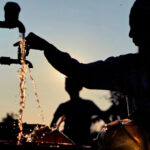At a seaside cafe in southern Lebanon’s Saida, 32-year-old Ahmad* recounted a family lineage of exile that is familiar among Palestinians in the diaspora. When Zionist militias displaced hundreds of thousands of Palestinians before, during, and after the 1948 war, his ancestors had fled Amqa, a village near Acre. Ahmad was born and raised in Ein al-Hilweh, the largest of Lebanon’s impoverished Palestinian camps.
That life in exile, in part, and a desire to return to his ancestral country, led Ahmad to join the armed wing of Hamas some 15 years ago. “My ultimate goal is to free Palestine,” he said. “The best and only way to return our rights and land is resistance.”
During the decade and a half since he signed up as a fighter in the Izz ad-Din al-Qassam Brigades, Ahmad has undertaken four years of intense religious training, two months of military training in Iran, and has largely abandoned daily pleasures like coffee and tobacco. In recent months, the young fighter said, he has spent time posted on Lebanon’s southern border to support the Lebanese armed group Hezbollah in its escalating fight against Israel.
On Oct. 7, Hamas, which governs the Gaza Strip, led a deadly attack that saw Palestinian fighters reach deep inside present-day Israel. Israeli forces then launched a military operation — the longest, most destructive, and deadliest of its five wars on Gaza since late 2008 — that has killed more than 25,000 people in the besieged coastal enclave.
Although Hamas had already enjoyed widespread popularity in the occupied West Bank and Gaza, many had considered it a “fringe group” in Lebanon’s crowded Palestinian political scene, according to Mohanad Hage Ali, a Beirut-based fellow at the Carnegie Middle East Center. In Lebanon, Hage Ali said, Hamas kept its military recruitment activities largely secretive.
But throughout the more than three months of Israeli airstrikes and ground invasion that has left Gaza in ruins since Oct. 7, Hamas’s popularity has surged in Lebanon, where growing numbers of people are joining its ranks.
As part of its recruitment strategy, Hamas “is trying to capitalize” on widespread anger over Israel’s war in Gaza, Hage Ali explained. Bolstered by its soaring popularity, the group has now “come out in the open” and “is recruiting at unprecedented levels within this short timeframe.”
“The Arab population at-large has been radicalized by what’s happening in the Gaza Strip — the massacres, the US and Western-backing of everything that has contributed to Palestinians suffering in Gaza,” Hage Ali added.
War crimes fuel recruitment
Swords and daggers decorate the snug sitting room belonging to a local Hamas leader in Saida, who goes by the nom de guerre Abu Abed Shanaa. Framed on a wall is a photo of Shanaa with Ismail Haniyeh, a founding Hamas member and chairman of the group’s political bureau.























